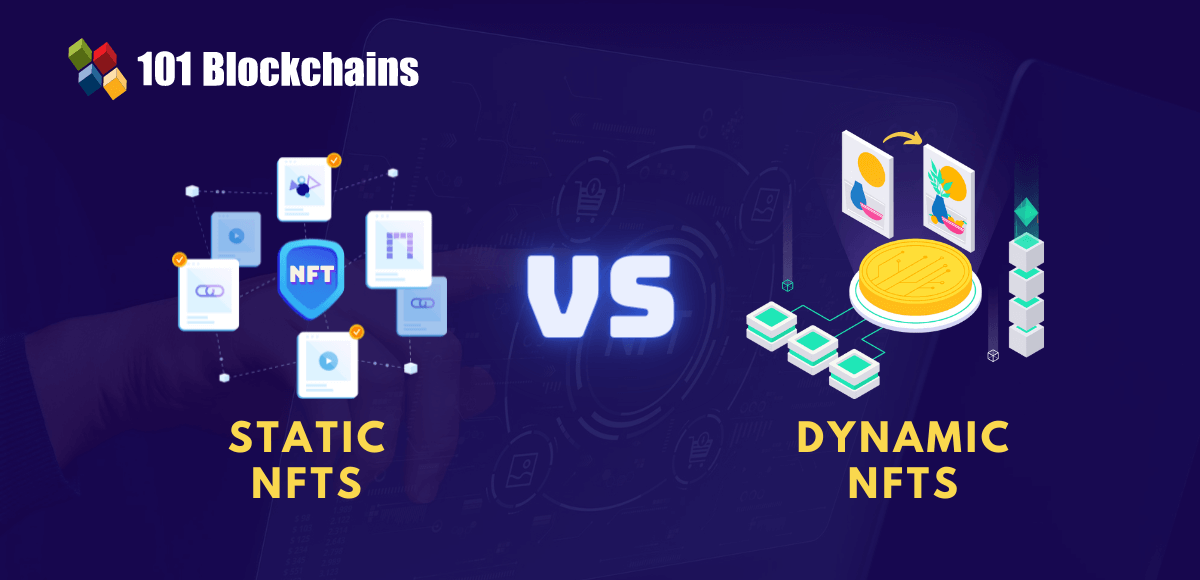The use of non-fungible tokens as one of the most noticeable applications of blockchain technology has been strengthened further with many new use cases. At the same time, the need for innovation in the design of NFTs creates the necessity for dynamic NFTs. The following post helps you figure out the difference between dynamic and static NFTs with a detailed assessment of each NFT category.
Aspiring to Become a Certified NFT Expert? Enroll in Certified NFT Professional (CNFTP) Course Now!
Basics of NFTs
One of the essential highlights for understanding the difference between static and dynamic NFTs would point at meaning of NFTs. Non-fungible tokens are basically digital assets with unique traits and, most important of all, non-fungibility. Every NFT has a unique value and cannot be interchanged with another digital asset, like cryptocurrencies.
For example, you can exchange 1 BTC for another BTC. However, you could never exchange one NFT for another NFT while safeguarding the same traits. Therefore, NFTs have emerged as favorable choices for representation of digital assets, such as art, videos, in-game items, music, virtual worlds and many other things.
The dynamic NFT vs static NFT comparison would also account for the fact that both of them have the backing of blockchain networks. Blockchain serves as a vital source of uniqueness and proof of ownership for non-fungible tokens. Most important of all, blockchain could also help in developing smart contracts, which help in automation of different NFT-related processes. Presently, Ethereum is one of the most renowned platforms for developing and trading non-fungible tokens.
Build your identity as a certified blockchain expert with 101 Blockchains’ Blockchain Certifications designed to provide enhanced career prospects.
Creation of NFTs
You can find the right answers to “How static NFT is different from dynamic NFT?” by exploring the working of Ethereum blockchain in detail. The decentralized platform helps in running smart contracts, which operate according to a specified set of conditions without any manual or fraudulent interference.
NFTs developed on Ethereum blockchain should follow the ERC-721 token standard, which specifies a particular set of rules tailored for NFTs on the Ethereum blockchain. The ERC-721 token standard specifies the rules for creating, transferring and destroying NFTs and has led to the rise of a massive NFT market. Some of the popular examples of NFTs include CryptoKitties, CryptoPunks, Gods Unchained and Decentraland LAND NFTs.
Excited to learn the basic and advanced concepts of ethereum technology? Enroll Now in The Complete Ethereum Technology Course
Different Categories of NFTs
Without diving further into redundant information, let us dive directly into the static NFT vs dynamic NFT comparison. You must note that all the NFTs are not equal, and the two distinct categories include static and dynamic NFTs.
As the name implies, dynamic NFTs are basically digital assets that could change properties over the course of time. For example, digital artwork NFTs can be developed as dynamic NFTs so that the artist can make modifications to the artwork after minting the NFT.
On the other side of the spectrum, static NFTs clearly suggest that they are digital assets you could not change after minting them. In simple words, a static NFT is immutable and permanent after the minting process is complete.
The difference between static and dynamic NFTs would always round up on their basic definitions. Users can create the desired NFT type according to the specific use case. It is evident that you should choose dynamic NFTs for assets that must go through updates or modifications over the course of time. On the other hand, you must choose a static NFT when you want to create an immutable permanent asset.
Irrespective of the NFT type you want, the ERC-721 standard is essential for ensuring that the NFT is tamper-proof and unique. With the potential for revolutionizing many industries, both static and dynamic NFTs could offer new ways of owning and trading digital assets. The thin line of difference between dynamic and static NFTs explains how they differ in design and use cases. A deeper investigation into the details of static and dynamic NFTs could help in drawing a better comparison between them.
Want to get an in-depth understanding of non-fungible tokens (NFTs)? Become a member and get free access to NFT Fundamentals Course.
1. Static NFT
Static NFTs are self-explaining and clearly indicate that you cannot change these NFTs. After creating static NFTs, they would be available as permanent and immutable blockchain records. The biggest highlight in a dynamic NFT vs static NFT would refer to the fact that static NFTs are useful for assets that are fixed. For example, digital identification documents, artwork or collectibles are examples of assets you can represent with static NFTs.
Static non-fungible tokens are also useful in permanent data storage on blockchain, like in a decentralized database. You can come across many advantages with static NFTs over dynamic NFTs. One of the crucial benefits of static NFTs is the assurance of better security, as you cannot modify them after minting. In addition, static NFTs also exhibit better efficiency and compatibility with many existing protocols and systems.
Interestingly, the answer for “How static NFT is different from dynamic NFT?” would also reflect on the disadvantages. One of the foremost setbacks in the design of static NFTs is the restriction on changing or updating the NFT. Therefore, you have to create a new NFT when you have to add or update information in an existing NFT.
As a result, you would have to compromise on flexibility with the use of static NFTs. On the other hand, static NFTs showcase compatibility issues with certain smart contract platforms. Therefore, you could not find many use cases that can make the most of static NFTs. However, static NFTs are the most popular type of NFT with the assurance of security and verifiable proof of ownership.
Want to learn blockchain technology in detail? Enroll Now in Certified Enterprise Blockchain Professional (CEBP) Course
Use Cases of Static NFTs
The static NFT vs dynamic NFT debate would also shed light on the potential use cases of static NFTs. The use cases for static NFTs include identity verification, digital art collections and document storage. Static NFTs are suitable for digital art collections as they provide an immutable representation of artwork on a blockchain.
Most important of all, artists can trade their work without any fear of unrequited modifications or ownership conflicts. Static NFTs also help in storing digital identity data and other important documents on the blockchain. In addition, static NFTs also serve as use cases for representation of in-game collectibles on blockchain with better security.
Advantages of Static NFTs
The advantages of static NFTs could showcase a basic impression of how they are better than dynamic NFTs. One of the first advantages of static NFTs refers to efficiency of bandwidth and storage requirements. Static NFTs are created and stored once, regardless of the number of transactions. In addition, static NFTs also present better ease of verification in comparison to dynamic NFTs. Static NFTs have all the information about token metadata in a single file.
On the other side of the dynamic NFT vs static NFT comparison, you have the dynamic NFTs with multiple related files for NFT data, thereby creating difficulties in verification. Above everything else, static NFTs offer better assurance of security against counterfeiting and fraud. Another prominent advantage associated with static NFTs refers to the versatility of use as shareable digital property or collateral for loans.
Start learning Non-Fungible Token with World’s first NFT Skill Path with quality resources tailored by industry experts Now!
2. Dynamic NFT
The latest entrant in the world of NFTs, dynamic NFTs, also referred to as DNFTs, stand true to their name. Dynamic NFTs could offer the flexibility for updating or changing the content of the NFTs, even after minting them. Therefore, you can find a better choice in the difference between static and dynamic NFTs for applications that require frequent modifications and updates in data. For example, NFTs for real-world assets which can change location and ownership can take on the form of dynamic NFTs. With the help of dynamic NFTs, the new owner of an asset could update the token metadata to reflect the necessary changes in ownership.
The working of dynamic NFTs shows how they can provide efficient store data in a modifiable format on blockchain networks. As a result, the DNFT owners could modify data associated with a specific token, particularly with reasonable permissions. Dynamic NFT owners could update the token data manually or set some conditions for automatic updates when the asset requires modifications.
The most popular example of dynamic NFTs refers to CryptoKitties, an NFT-based game where players can breed, sell or purchase digital cats. Dynamic NFTs represent the digital cats, and owners can update the token metadata for changing the cat’s traits such as appearance, genes and personality. Another popular example for dynamic NFTs would refer to Decentraland, a virtual metaverse world. Users can rely on DNFT functionalities for ensuring relevant modifications in the details of virtual land parcels within Decentraland.
Aspiring to Become a Certified Metaverse Expert? Enroll in Certified Metaverse Professional (CMP) Certification Course Now!
Use Cases for Dynamic NFTs
The critical aspect for finding out solutions to “How static NFT is different from dynamic NFT?” would refer to the use cases. Dynamic NFTs are promising choices for different applications such as games, digital artwork and many other use cases which need frequent updates or changes in data. Dynamic NFTs can help in creating ever-evolving digital artwork.
Similarly, they can also help in representation of in-game assets which need changes alongside the progress of players. The use cases of dynamic NFTs in the field of real-world collectibles also enable changes in the NFTs according to external market conditions and other factors. For example, sports cards following a specific athlete’s career can fluctuate in value depending on the athlete’s performance in recent tournaments.
Advantages with Dynamic NFTs
The basics of dynamic NFTs and their use cases provide a solid impression of the possible advantages associated with them. You can uncover many crucial points for a static NFT vs dynamic NFT debate with an overview of the benefits of DNFTs. The most noticeable benefit associated with dynamic NFTs is the flexibility for modifying the NFTs according to your requirements.
Therefore, brands can design NFTs tailored to the target audience’s preferences and requirements. With the flexibility for frequent evolution of NFTs, users are more likely to interact with dynamic NFTs for longer times. As users develop confidence in the ability to discover new things, such as improved NFT collectibles, the immersive experiences of users can also hold them on to the NFTs for longer. Most important of all, the flexibility for content creation and distribution with DNFTs offers possibilities for better user experiences.
Differentiating Static NFT vs Dynamic NFT
The outline of different categories of NFTs into two distinct camps leaves little room for comparison. For starters, you can notice that dynamic NFTs allow changes after minting, while static NFTs don’t. Along the same lines, dynamic NFTs are more suited for use cases that require frequent updates and modification of data.
Static NFTs can find applications in use cases that deal with fixed data. You can notice how static NFTs imply a lack of flexibility in comparison to dynamic NFTs. However, dynamic NFTs can present vulnerabilities due to the different data structures of the token. On the contrary, static NFTs have a single file for storing token metadata, thereby ensuring better security.
Get familiar with the terms related to non-fungible token with Non-Fungible Token Flashcards
Final Words
The dynamic NFT vs static NFT debate ultimately lands on a reasonable conclusion. The allocation of each type of NFT to desired use case determines their necessity. If you want to find a better alternative, then you must take a look at your desired use case. Dynamic NFTs can serve as the best picks for use cases where you have to modify or upgrade token data.
On the other hand, static NFTs are the perfect choice for applications where you deal with immutable NFTs. The most important thing to note here is that static and dynamic NFTs have their unique strengths and pitfalls. Ultimately, the user has to decide the type of NFT they want to create based on their desired use case. Learn more about dynamic NFTs and explore their fundamentals.
Join our annual/monthly membership program and get unlimited access to 35+ professional courses and 60+ on-demand webinars.
*Disclaimer: The article should not be taken as, and is not intended to provide any investment advice. Claims made in this article do not constitute investment advice and should not be taken as such. 101 Blockchains shall not be responsible for any loss sustained by any person who relies on this article. Do your own research!







